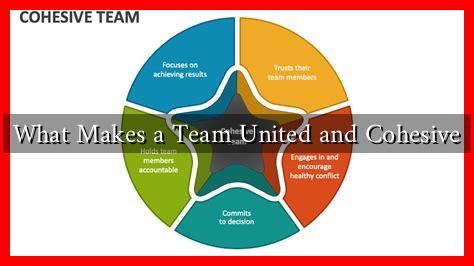-
Table of Contents
What Makes a Team United and Cohesive
In today’s fast-paced and interconnected world, the success of any organization hinges on the effectiveness of its teams. A united and cohesive team not only enhances productivity but also fosters a positive work environment. But what exactly makes a team united and cohesive? This article delves into the key factors that contribute to team unity and cohesion, supported by research, examples, and case studies.
The Importance of Team Cohesion
Team cohesion refers to the bonds that hold a group together, influencing how well they work towards common goals. According to a study published in the *Journal of Applied Psychology*, cohesive teams are 20% more productive than their less cohesive counterparts. This statistic underscores the importance of fostering unity within teams.
Key Factors Contributing to Team Unity
Several elements play a crucial role in creating a united and cohesive team. Here are some of the most significant factors:
- Clear Goals and Objectives: Teams need to have a shared understanding of their goals. When everyone is aligned on what they are working towards, it fosters a sense of purpose.
- Open Communication: Effective communication is vital for team cohesion. Team members should feel comfortable sharing ideas, feedback, and concerns without fear of judgment.
- Trust and Respect: Trust is the foundation of any successful team. When team members respect each other’s skills and contributions, it enhances collaboration.
- Diversity and Inclusion: A diverse team brings different perspectives and ideas, which can lead to innovative solutions. Inclusion ensures that all voices are heard and valued.
- Team-Building Activities: Engaging in team-building exercises can strengthen relationships and improve communication among team members.
Case Studies: Successful Cohesive Teams
To illustrate the importance of team cohesion, let’s look at a couple of successful case studies:
Case Study 1: Google’s Project Aristotle
Google conducted an extensive study known as Project Aristotle to determine what makes teams successful. The findings revealed that psychological safety—where team members feel safe to take risks and be vulnerable—was the most critical factor in team effectiveness. Teams that fostered an environment of trust and open communication outperformed others significantly.
Case Study 2: The Navy SEALs
The Navy SEALs are renowned for their exceptional teamwork and cohesion. Their training emphasizes trust, communication, and shared goals. Each member is trained to rely on their teammates, creating a strong bond that is crucial during high-stakes missions. This level of cohesion is a key reason for their success in challenging environments.
Statistics on Team Cohesion
Research has shown that cohesive teams yield significant benefits. Here are some compelling statistics:
- According to a study by the *Institute for Corporate Productivity*, organizations with high team cohesion experience 50% lower turnover rates.
- A report from Gallup indicates that teams with high engagement levels are 21% more productive.
- Research from the *Harvard Business Review* found that cohesive teams are 25% more likely to achieve their goals.
Strategies to Enhance Team Cohesion
To cultivate a united and cohesive team, consider implementing the following strategies:
- Regular Check-Ins: Schedule regular meetings to discuss progress, challenges, and celebrate successes.
- Encourage Feedback: Create a culture where constructive feedback is welcomed and acted upon.
- Foster Social Connections: Organize social events to help team members bond outside of work-related tasks.
- Provide Training: Invest in training programs that focus on teamwork and collaboration skills.
Conclusion
In conclusion, a united and cohesive team is essential for achieving organizational success. By focusing on clear goals, open communication, trust, diversity, and team-building activities, organizations can foster an environment where teams thrive. The case studies of Google and the Navy SEALs highlight the profound impact of cohesion on performance. As the statistics suggest, investing in team unity not only enhances productivity but also reduces turnover and increases overall job satisfaction. By implementing the strategies outlined in this article, organizations can build stronger, more cohesive teams that are equipped to tackle any challenge.
For further reading on team dynamics and cohesion, consider exploring resources from the Harvard Business Review.

